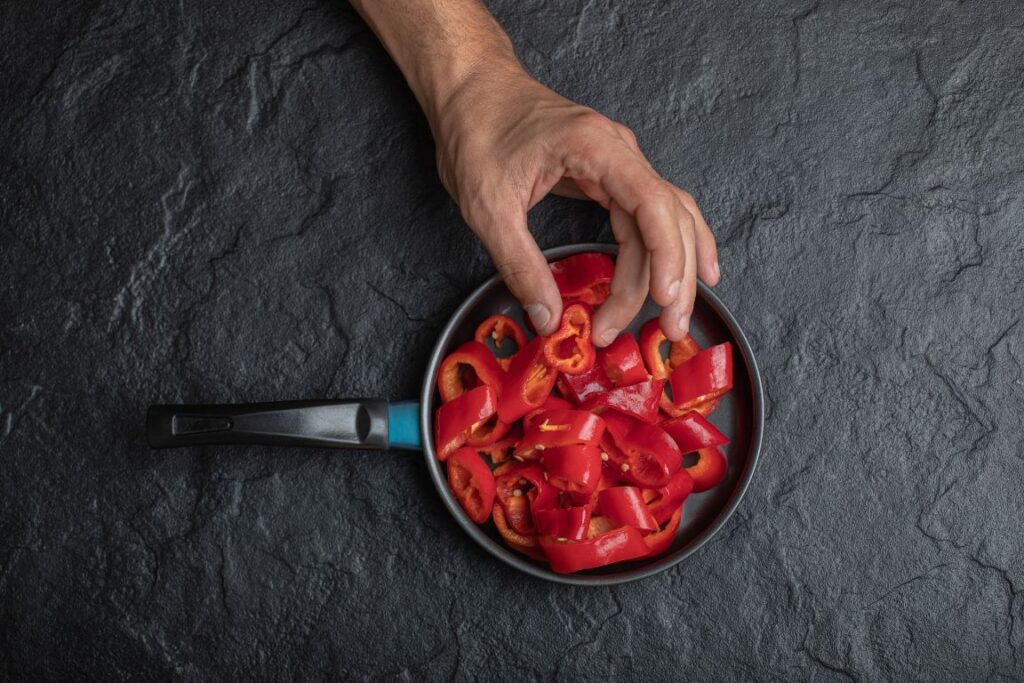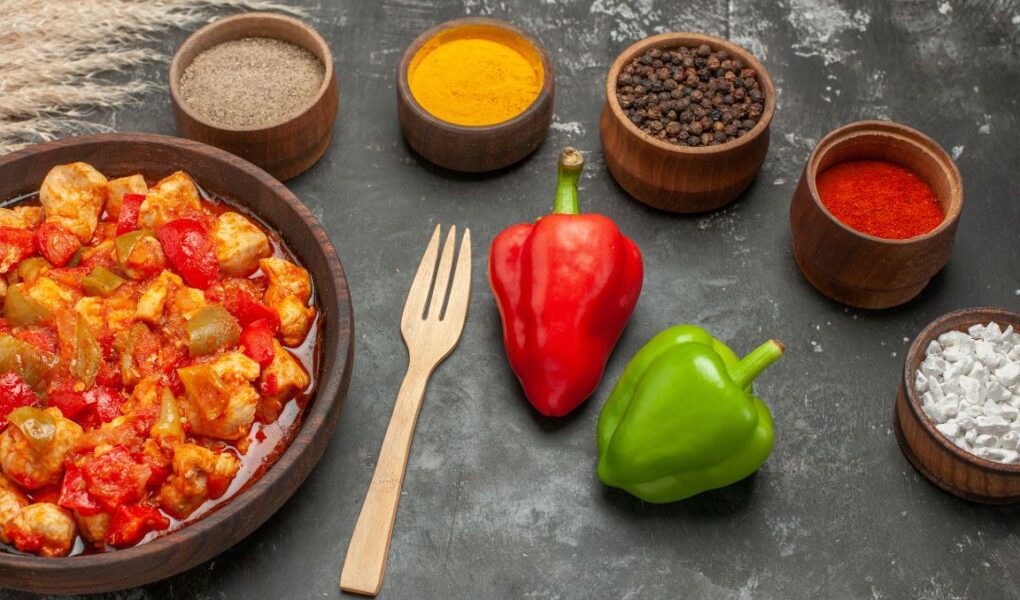Are you intrigued by the notion of a hearty, flavor-packed vegan chili that’s good for your body and our planet? Or are you seeking a new twist on the traditional chili con carne, but without the meat, of course? You’ve come to the right place! This easy-to-follow vegan chili recipe will guide you through each step to create a pot of savory goodness that’s so filling and delightful, you won’t believe it’s vegan!
Is it hard to prepare a vegan chili recipe?
Not at all! It’s true that vegan chili might sound intimidating, especially if you’re new to plant-based cooking. However, with the right ingredients and a bit of patience, you’re in for a feast you’ll want to make over and over again. Let’s talk about the key steps in preparing vegan chili.
Gathering Your Ingredients
First and foremost, you’ll need to collect all the essential ingredients. You’ll find many of these already in your kitchen! Some of the core ingredients of vegan chili include kidney beans, black beans, tomatoes, bell pepper, onion, and garlic. If you want to flavoring, items like cumin, chili powder, paprika, and oregano are essential.
For this hearty vegan chili, you’ll need the following ingredients in the specified proportions: two cups of chopped onions, one and a half cups of chopped bell peppers, and two cloves of minced garlic for the base. For the main components, gather three cups of vegetable broth, two cans (15 ounces each) of kidney beans, and one can (15 ounces) of black beans. All beans should be drained and rinsed.
Preparing Your Vegetables
Next, you’ll chop your vegetables. Cut the onions and bell pepper into bite-sized pieces and mince the garlic. We want these ingredients to be well blended into our chili, providing texture and flavor without being overwhelming.
For the vegetables, you’ll need one cup of corn (frozen or fresh), two cans (14.5 ounces each) of diced tomatoes, and two medium-sized carrots, diced. The spices to bring out the flavor include two tablespoons of chili powder, one tablespoon of cumin, one teaspoon of oregano, and a half teaspoon of smoked paprika. Adjust these to taste.
Cooking the Chili
Now, here is the fun part; cooking vegan chili! Start by sautéing the onions until they become translucent. Next, add in the garlic and bell pepper. As an optional step, you can put in a splash of vegetable broth to prevent sticking and to add more flavor. After the veggies are cooked, we introduce our spices, following with tomatoes and beans. Let everything simmer for about 30 minutes. The longer your chili cooks, the deeper the flavors will be!
Final Touches
In the end, it’s time to put the finishing touches on your vegan chili dish. You can add a squeeze of lime for a bit of tanginess, some fresh coriander for a natural herbal kick, or even a spoonful of vegan yogurt for a creamy texture.
Finally, for a unique touch, include one cup of quinoa, rinsed. This will give your chili a hearty texture and additional protein. Don’t forget to season with salt and pepper to taste. If you like a bit of heat, you can also add one jalapeno, finely chopped, or a pinch of cayenne pepper.
As you can see, making delicious, hearty vegan chili is not intimidating at all. You are simply preparing and combining ingredients, then letting them simmer to perfection. Start experimenting in your own kitchen – the flavorsome vegan chili awaits you!
Chili originated from what is now northern Mexico and southern Texas, with the traditional recipe using beef and chili peppers.
Is it hard to prepare a vegan chili?
Creating a masterpiece like vegan chili doesn’t have to be a Herculean task, requiring neither exceptional culinary expertise nor hours bent over the stove. Equipped with our step-by-step guide, anyone can effortlessly whip up a delectable pot of this spicy, hearty dish.

Spicing up your Chili
The boon and bane of any good chili is its spice blend. It’s where you can play artist, mixing and matching to strike a balance that speaks to your soul and palette. Chili powder, cumin, paprika, oregano, even a dash of unsweetened cocoa powder—experiment to create your signature vegan chili.
Remember to be bold, but thoughtful when seasoning. Start with smaller amounts—you can always add, but you can’t take away. Once you’ve toasted and mixed your spices, it’s time to incorporate them into your chili.
Simmering your way to Perfection
The simmer is where the magic happens. It’s during this gentle, slow cook that your ingredients mingle and merry, with every chunk of vegetable soaking up the flavorful broth. The simmer is also where your patience gets tested, but let me assure you, it’s worth the wait.
Let your chili simmer away for 30 minutes to an hour on low heat. Stir occasionally to prevent burning and to ensure all components equally share in the heat and flavor. During this time, the flavors not only enhance, but also come together to make your vegan chili the ultimate comfort food.
The Art of Serving Vegan Chili Recipe
Serving is more than spooning chili into a bowl, it’s the culmination of your cooking journey and the way to make your dish even more special. A dollop of vegan sour cream, a sprinkle of sliced green onions, or a handful of cilantro—each adds brightness and texture, elevating your vegan chili to a gourmet experience.
Don’t forget the crusty bread or warm tortilla chips. They offer a satisfying crunch and a way to soak up any lingering, spicy, chili-infused broth. With your bowl garnished, it’s finally time to sit back and revel in your handiwork with the first, most satisfying spoonful. Also, Enjoy this hearty dish with our Sweet Potato Quinoa Salad for a balanced, nutritious meal
Nutrition Information
For a typical vegan chili recipe, the main ingredients include beans, vegetables like bell peppers and onions, tomatoes, and spices. Beans are a great source of protein and fiber. A cup of cooked black beans, for instance, provides around 15 grams of protein and 15 grams of fiber, which is 30% and 60% of the daily recommended intake respectively.
Vegetables like bell peppers and onions not only add flavor but also provide essential nutrients. A cup of chopped bell peppers provides more than 100% of the daily recommended intake of vitamin C, while a cup of chopped onions provides around 20% of the daily recommended intake of vitamin C and 10% of vitamin B6.
Spices like chili powder, cumin, and garlic not only add flavor but also have health benefits. For instance, chili powder contains capsaicin, which has been shown to boost metabolism and reduce hunger. Cumin is rich in iron, providing around 20% of the daily recommended intake in a teaspoon. Garlic has been linked to a number of health benefits, including improved heart health and immune function.
Overall, a bowl of vegan chili can provide a significant percentage of the daily recommended intake of many nutrients, making it a healthy and nutritious choice. However, the exact percentages can vary depending on the specific recipe and portion size.
What are some common mistakes when cooking vegan chili recipe?
Stepping into new culinary territories can sometimes lead to unexpected twists and turns, and preparing vegan chili might be just that adventure for some of you. Discovering the world of vegan cuisine involves learning from your mistakes and refining your craft. Here are some of the most common mistakes to look out for when cooking a vegan chili for the first or twentieth time.
Vegan chili can be cooked on the stovetop, in a slow cooker, or in an Instant Pot, with cooking times varying depending on the method used.
Using the Wrong Beans
A common pitfall wannabe chili masters often stumble upon is using the wrong type of beans. Kidney beans have been the traditional go-to, but navy, black, or pinto beans deliver an equally delicious flavor spectrum while adding a bit of a twist to your staple chili recipe. Beyond the basic considerations of taste and texture, picking the right beans can also influence the cooking time – a factor you doubtless want to maximize your control over.
Neglecting Fresh Ingredients
Another common mistake is sidelining fresh ingredients. When cooking vegan chili – or any dish, for that matter – using fresh vegetables and herbs can amplify the flavor significantly, elevating your chili from merely good to truly exceptional. Don’t resort to canned or frozen veggies – fresh bell peppers, tomatoes, and cilantro can work wonders when it comes to adding depth and freshness to your dish.
Overlooking the Importance of Seasoning
The flavor of a chili truly lies in its seasoning. Any seasoned foodie will tell you that it’s essential to build your flavors gradually during cooking. Dash salt at each stage, adjust your spices as you taste your chili, and don’t shy away from doubling the spice if you want that extra kick. Remember – the spiciness of your chili is not solely dependent on the amount of chili you use. Even the humble cherry tomato can make your vegan chili sing with added sweetness, balancing out the heat quite perfectly. So, don’t limit your imagination when it comes to spices and seasonings.
Rushing the Cooking Process
Last but not least, the most common – and perhaps fatal – mistake is rushing the cooking process. The depth of flavor in a chili comes from allowing it to simmer over time, allowing the flavors of all your carefully picked ingredients to meld together into a one-pot wonder. If you rush this process, your chili may lack complexity and taste rather flat. Remember, patience is a virtue and in this case, it’s your key to a delicious vegan chili.
Are there any gluten-free options for vegan chili meal?
Absolutely! It’s entirely possible to adapt your vegan chili recipe to make it completely gluten-free while keeping it just as tasty and satisfying. Your efforts toward dietary inclusivity will be appreciated by your guests who follow a gluten-free lifestyle as you offer options to meet their dietary needs. Adapting this recipe is way simpler than you might assume, and the steps are laid out for you below.
Selecting Gluten-Free Thickeners
Regular chili recipes often use flour as a thickening agent, which contains gluten. But not to worry, there are gluten-free thickeners out there! An excellent option is cornstarch, gluten-free flours like rice or chickpea flour, or even mashed potatoes. Remember to add these thickeners gradually and stir continuously to avoid lumps.
Checking for hidden Gluten
Gluten can sneak in from the most unexpected places. So, pay close attention to ingredients like vegetable broth, canned tomatoes, and sauces. Make sure you’re selecting gluten-free certified products for these ingredients. If you’re in doubt, always read the ingredient list on the product’s label.
Choosing Gluten-Free Sides
Don’t forget about the sides! If you love accompanying your chili with bread, opt for gluten-free alternatives. You can also go for rice or quinoa, both of which are naturally gluten-free grains, or opt for a refreshing gluten-free salad as a side.
To conclude, preparing a gluten-free vegan chili is as simple as mindful shopping and careful ingredient selection. So don’t hesitate to try it out if you or anyone you will be serving has gluten intolerance or allergy. You’ll find it’s just as delicious and satisfying!
Can I add vegetables to my vegan chili recipe?
Of course, you can! Adding an array of vegetables not only increases the nutritional profile of your vegan chili, but it also enhances the flavors, making it a more satisfying meal. Don’t hesitate to diversify your vegan chili with a colorful medley of vegetables.
Deciding on Your Vegetable Mix
Picking the right vegetables is an art in itself. The combinations are endless. Start with some classics like bell peppers, zucchini, and corn. They tend to keep their shapes well and have mild flavors that blend seamlessly with the chili base. Then, consider adding more unusual suspects like butternut squash or sweet potatoes for a touch of natural sweetness. Dark leafy greens such as kale or spinach can be stirred in right at the end for an extra dose of nutrition.
Adding the Vegetables to Your Chili
How and when you add the vegetables to your vegan chili can greatly influence the texture and flavor of your dish. Hearty, root vegetables, like carrots or potatoes should be added early on in the cooking process along with the beans to ensure they have enough time to become tender. On the other hand, delicate vegetables that cook quickly, like bell peppers or zucchini, can be added towards the end to keep them from turning mushy. Always remember, the aim is to achieve a balance of flavors and textures to create a chili that’s wholesome and enjoyable.
Considering Seasonal Vegetables
Incorporating seasonal vegetables into your vegan chili recipe is a brilliant way to harness the freshest flavors while supporting sustainable farming practices. Spring might inspire the addition of fresh peas and asparagus tips; summer could bring sweet corn and ripe tomatoes; root vegetables shine in the fall; and winter earmarks hearty squash and kale. Seasonality not only affects the taste and nutritional quality of your vegetables but it also adds variety to your vegan chili throughout the year!
More Easy Vegan Meals to cook in family
How do I store leftover Vegan chili meal?
Storing your leftover vegan chili properly is crucial to maintaining its freshness and ensuring it can be a delightful meal again. Here’s a helpful guide to walk you through the storing process, whether it’s for short-term or long-term storage, and how to reheat your chili appropriately when you’re ready to enjoy it again.
Storing in the Refrigerator
Your vegan chili can safely be stored in the refrigerator. Only if you plan to consume it within 2 to 3 days. To do this, let the chili cool completely then transfer it into an airtight container. Make sure the lid fits tightly, then place the container in the refrigerator. It’s important not to leave the chili sitting out at room temperature for more than 2 hours to avoid it spoiling.
Freezing for Long-Term Storage
But what if you’ve made a large batch of vegan chili and want to enjoy it later? Freezing is your best option. Again, allow the chili to cool completely before transferring it into a freezer-safe container or heavy-duty freezer bags. Remember to leave some space in the container, as the chili expands when it freezes. You can also divide the chili into individual portions for easier thawing and reheating in the future. Your frozen vegan chili can be stored up to 4 to 6 months.
Reheating Your Leftover Vegan Chili Recipe
When you’re ready to dive back into your chili, you can reheat it in a few simple steps. If it’s refrigerated, you can place it back into your saucepan and reheat on the stove over medium heat until it is heated through. If it’s frozen, it’s best to thaw it in the refrigerator overnight before reheating. Never refreeze your thawed chili – it decreases the quality and can introduce health risks.











